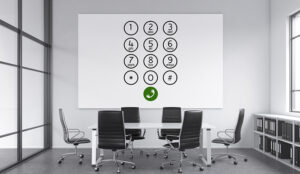The term call accounting (or call logging) system is commonly applied to a telecoms hardware or software application that captures, records and costs telephone usage events.
Most businesses that use such systems have primarily implemented them as a cost optimisation application for their communications infrastructure. It’s a form of usage from which almost every business across any vertical sector could derive benefits – from the largest enterprise to the smallest SMB.
Consequently, it’s a solution with a wide range of use cases. Call accounting is used to help define and drive a new business strategy or approach, and is frequently used as a cost-justification tool to build a business case for a migration process from TDM to voice over IP (VoIP). If the business is operating some sort of unified communications platform like Skype for Business, call accounting can be very helpful in enabling the organisation to look at its whole approach to communications – measuring everything from audio to video conferencing, instant messaging, file transfers and peer-to-peer calls. It’s a great way of identifying trends which may have a significant cost impact on the business and may therefore require contingency plans to be developed.
The best call accounting systems are also flexible enough to enable specific functionality to be developed to optimise reporting for a particular type of environment – whether that be traditional audio or PSTN data, Skype for Business solutions or more general unified communications technology. Alternatively, the business might want to look more closely at the network level. focusing on areas like quality of service, packet loss, latency jitter or overall network performance to ensure optimal efficiency of the voice network.
Call accounting is an approach that delivers benefits to all parts of the organisation, extending far beyond the contact centre and customer-facing business units right through to the back-office administrators. That said, there are clearly some specific functional areas of any business to which call accounting software is especially relevant. Here, we examine each of these areas in turn and look at how organisations can optimise the benefits they derive from them.
Cost optimisation
Arguably, the primary benefit of call accounting systems is the ability to optimise costs. This breaks down into a number of different areas. The first focus typically is on carrying out an analysis of call costs across the organisation. Often that involves systems calculating internal call costs plus calculations of costs as calls break out from the organisation to the public switched telephone network (PSTN). With the most functionally rich call accounting systems, businesses can use multiple different carrier tariff rates – available within the application – to calculate call costs. Our own call accounting system, Proteus, allows users that are taking service from multiple providers to load up rate plans for each and run cost comparisons to ensure that they are on the right plan for their type of usage and that it is working optimally for them.
Another key area where cost management comes into play is identifying assets within the organisation that are either being underutilised or are not being used at all, and which could potentially be shared across different areas of the business. It’s effectively a form of cost rationalisation for infrastructure and it’s the kind of application that clearly demonstrates why cost management and optimisation is the area of call accounting where businesses typically see the fastest return on investment.
The third key area around costs relates to the way those costs are applied within a business. If, for example, you have a company-wide telephone bill and you want to split that down by department, or possibly even by employee, the cost reporting within a call accounting application provides a cost allocation across departments or cost centres or account codes or other entities so that you can allocate costs and account for them appropriately. That’s generally done on a scheduled basis so you automate the cost allocation reporting each month, for example. In a typical scenario, the finance team then receives a report which is subsequently charged back to departments or employees.
The final cost area that call accounting systems often assist with is service billing. There are a couple of key use cases here. Let’s say you are a legal firm, charging clients for time and materials used. Typically, in this scenario, you would assign an individual account code to every client, which would be used to collate all of the calls for that particular client – and if there are associated costs, you can apply a mark-up on those as and when appropriate. You can then generate a monthly billing report every month and charge your client – it’s a simple, fast and efficient way of managing call accounting.
Network optimisation
Network optimisation is a key element of any call accounting system but it is one that is perhaps most relevant to medium to large enterprises that might have quite sophisticated telephony infrastructures, potentially incorporating multiple sites, multiple PBXs and large volumes of SIP or ISDN trunks terminating in various buildings across their estate. Enghouse Interactive itself is a case in point. We have a total of 1,500 employees and dozens of offices around the world, with a communications infrastructure linking each of those to the PSTN and to an internal VPN, and a clear understanding through monitoring and managing that infrastructure is very important to our business.
Network optimisation is indeed another key area where leading-edge call accounting systems can assist organisations. They can, for example, use the approach to assess average peak utilisation across the network. They can also look to ensure that organisations are using least-cost routing to route calls internally and break them to the PSTN network.
Call accounting can also help with capacity planning. The best systems can see how capacity is trending on the network. They can be very good at predicting when the business is likely to reach capacity and managing growth accordingly. Alternatively, they can project a likely decline over time, which might help the business to identify where it can reduce the number of assets and achieve some cost savings as a result.
Security and compliance
This involves monitoring telephone interactions for events and activity that the business is not expecting. That could mean out-of-hours breakout calls which might indicate some sort of toll fraud (a method of obtaining unlawful access to business phone systems to make money). Toll fraud is rife in the UK but it is nevertheless a threat that most businesses do not truly understand or defend themselves against.
In this kind of scenario, businesses need to be notified immediately anything untoward happens. Our own Proteus call accounting system, for example, has a real-time monitor, which can be configured when the office is closed down – for the Christmas holidays, for example – to ensure that if there were any out-of-hours outbound calls over a certain amount, the management team is notified by email or SNMP.
Call accounting systems can also be used to detect internal fraud, including unnecessary use of long-distance or toll-based services by someone internal to the organisation (although not necessarily a member of staff).
Trevor Davis, Head of Product Management– Call Accounting, Enghouse Interactive, commented: “Unfortunately, abuse of communication facilities is now becoming a widespread issue in most businesses. We are hearing more and more instances of companies being targeted by scams, such as premium rate number companies paying cleaners to dial a number and leave it hanging while they are in the office, only hanging up at the end of the evening when they leave the building. In today’s tough economic situation, businesses are looking to cut costs and make processes as efficient as possible.”
A strong focus on security and compliance is not all about protection against fraud, though. It might also mean developing some kind of option within the software to manage business and personal calls more effectively. This could be as simple as building a set of business numbers in order to differentiate between business and personal usage. This can help to manage costs. If employees are aware that they are being monitored for personal call usage, they may be less inclined to use a phone for their personal needs. Some businesses even like to charge employees for personal calls, so there’s clearly an application for call accounting here also.
This kind of usage of call accounting systems may be especially pertinent in certain vertical markets like finance and banking – areas where there may be very tight regulation on staff activity. Proteus can be used to verify trader activity and pinpoint who they are calling, how frequently they are calling that person, the duration of calls and, more importantly, the costs associated with them.
It can, after all, cost many thousands of pounds a month to provide an individual trader with telephony services. Businesses naturally want to ensure they are getting value for money out of that network and that it is not being used in a fraudulent fashion, or indeed breaking regulatory requirements in any way.
Staff activity monitoring
Most modern call accounting applications have the ability to display activity on a wallboard or a dashboard which can monitor metrics like inbound call times or call-wait times and then set appropriate thresholds. The business might, for example, set a target of a no more than 20-second wait time for customers. In the event of those thresholds being exceeded, the wallboard will change colour, going from green to amber to red. Organisations are also able to use call accounting systems to monitor staff productivity in a contact centre environment. In this way, they can answer questions like: Which members of staff are making the most calls a day or are on the phone for longest? Is a particular call time being exceeded by any particular member of staff on a regular basis? Who is making the most expensive calls? In other words, they can create vast reams of statistics in this area, helping organisations manage staff productivity, drive SLAs and meet key performance indicators (KPIs) for telephony within the organisation.
Take back control

Trevor Davis
Ultimately, the best call accounting systems help businesses enhance the control that they exercise over their telephony infrastructure. And that enhanced control brings them a vast array of different benefits, from better capacity planning to the ability to rapidly identify cost savings, drive up productivity levels and stop fraud in its tracks. So, it makes sense for any business that wants to reduce their telecoms spend, protect against misuse and fraud and get a rapid return on their investment in new solutions, to begin to plan their approach and start looking now into the many benefits that high-quality call accounting systems can bring.
With thanks to Trevor Davis, head of product management, call accounting, Enghouse Interactive
Author: Rachael Trickey
Published On: 29th Sep 2016 - Last modified: 5th Mar 2019
Read more about - Archived Content, Enghouse Interactive







